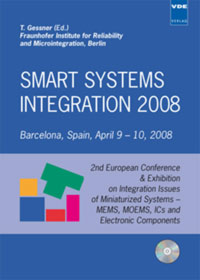INKtelligent printing of metal and metal alloys for sensor structures
Konferenz: Smart Systems Integration 2008 - 2nd European Conference & Exhibition on Integration Issues of Miniaturized Systems - MOMS, MOEMS, ICS and Electronic Components
09.04.2008 - 10.04.2008 in Barcelona, Spain
Tagungsband: Smart Systems Integration 2008
Seiten: 6Sprache: EnglischTyp: PDF
Persönliche VDE-Mitglieder erhalten auf diesen Artikel 10% Rabatt
Autoren:
Maiwald, M.; Günther, B.; Ruttkowski, V.; Werner, C.; Müller, M.; Godlinski, D.; Wirth, I.; Zöllmer, V.; Busse, M. (Fraunhofer Institute for Manufacturing Technology and Applied Materials Research, Bremen, Germany)
Inhalt:
INKtelligent printing(R) denotes the fabrication of functional structures, e. g. conductive paths and sensor structures, with the help of maskless printing technologies like inkjet and aerosol printing. The main objective for this research is a surface or component with improved performance due to better and new properties like crack detection or temperature measurement. The application areas for INKtelligent printing(R) are multifaceted comprising automotive, aerospace and life science. An important requirement for the use of printing technologies is the availability of a suitable base material, in this case a suspension containing nanosized particles, so called functional ink. Such inks can be printed on planar and even non-planar surfaces with resolutions down to ten microns or even below. The printing process is followed by a thermal treatment e.g. in a furnace or with a laser to achieve dense functionalized structures. This paper highlights the development and processing of metal inks based on Ag and a Cu/Ni alloy. Both materials are fabricated with a physical sputter process called Vacuum Evaporation on Running Liquids (VERL) technology where particles are directly sputtered into fluids. Among the fabrication process the printing on different surfaces with an aerosol printing technology called M3D(TM)(Maskless Mesoscale Material Deposition) as well as different sintering methods of Ag and Cu/Ni structures are demonstrated. Results are discussed in view of possible use for sensor applications.


